
There are some good reasons (beyond disease resistance and low maintenance) why I decided to plant my 1-acre garden with more than 100 conifers. They have vibrant colors and interesting textures, and they provide a strong year-round presence—not to mention that they are arguably one of the lowest-care plants out there. And before you start saying that only northern gardeners can benefit from a garden filled with these evergreen treasures, I should mention that I live in Tennessee.
Learn more: 9 Colorful Conifers That Will Energize Your Winter Landscape
For all the good things that conifers provide to a garden, they can be tricky to design with. Because they are ever-present structures, they can easily be situated in the wrong spot, where they end up sticking out like a sore thumb instead of creating a strong foundation. And because their foliage is unique in the world of plants, their texture can be difficult to blend with traditional perennials. To top things off, certain conifers have coloring that is searing—which can be a blessing but also a hindrance when trying to highlight the coloring without making the landscape look garish. Over many years of experimenting, I have discovered a few tricks and tips that make designing with conifers easier. Using this advice will almost certainly give you the striking yet low-maintenance garden you’ve always wanted.
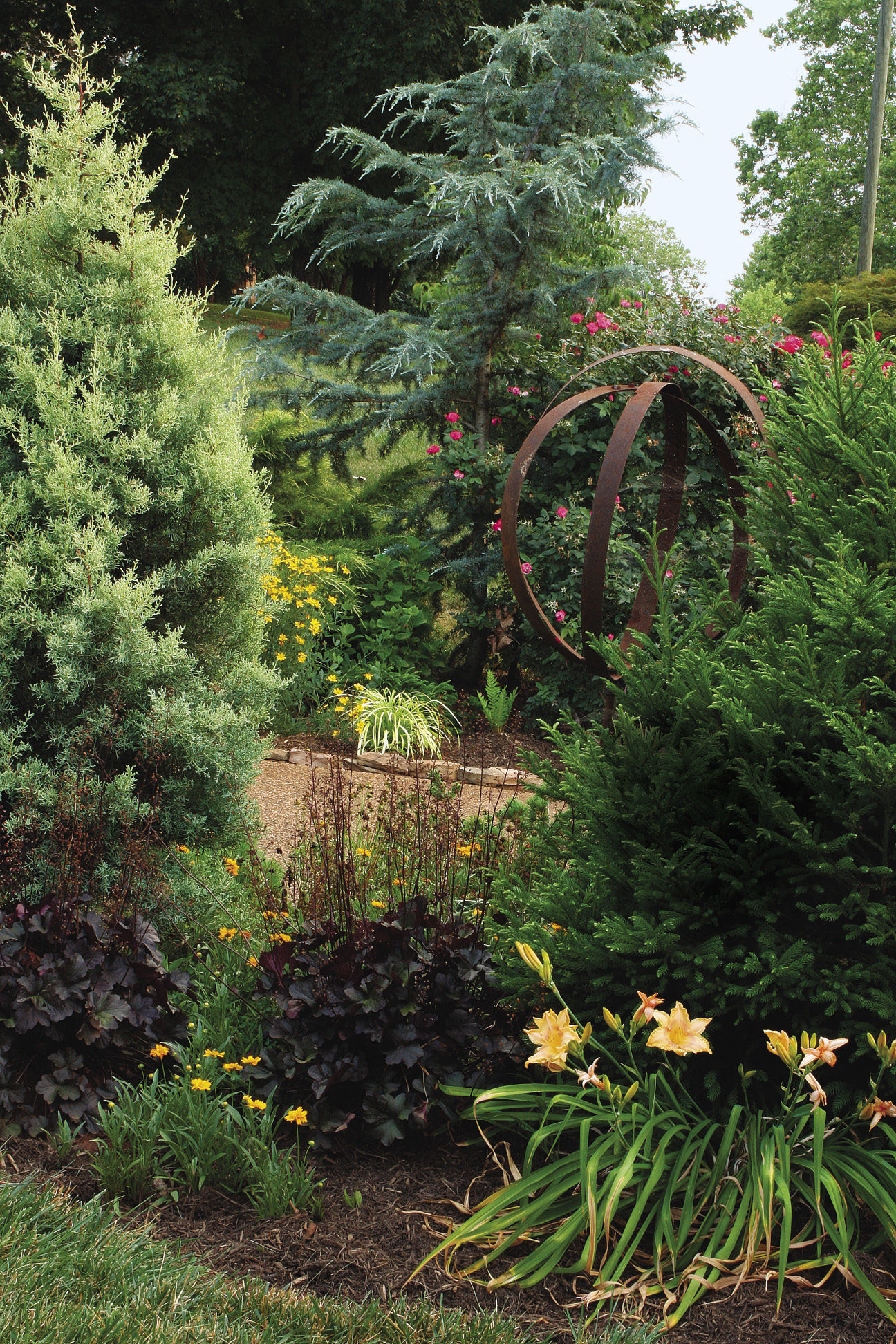
Use strong shapes to establish anchors
Because almost all conifers are evergreen regardless of zone, they will often be the only things that remain the same in your ever-changing beds. Because these plants grow slowly and seldom change silhouettes, you need to select spots that will highlight their forms without causing them to stick out. I base the placement of my conifers on their shape: prostrate, vertical (which can be upright or weeping), and round. Although I find some shapes easier to work with than others, it’s important to have at least a few of each in every garden for variety. Conifers with strong forms also tend to be the most eye-catching. To establish year-round continuity throughout the garden, I like to strategically place in my beds a few conifers with shapes that make an impact. That way, no matter what the time of year, these bold anchors will draw attention and pull the landscape together as a whole.
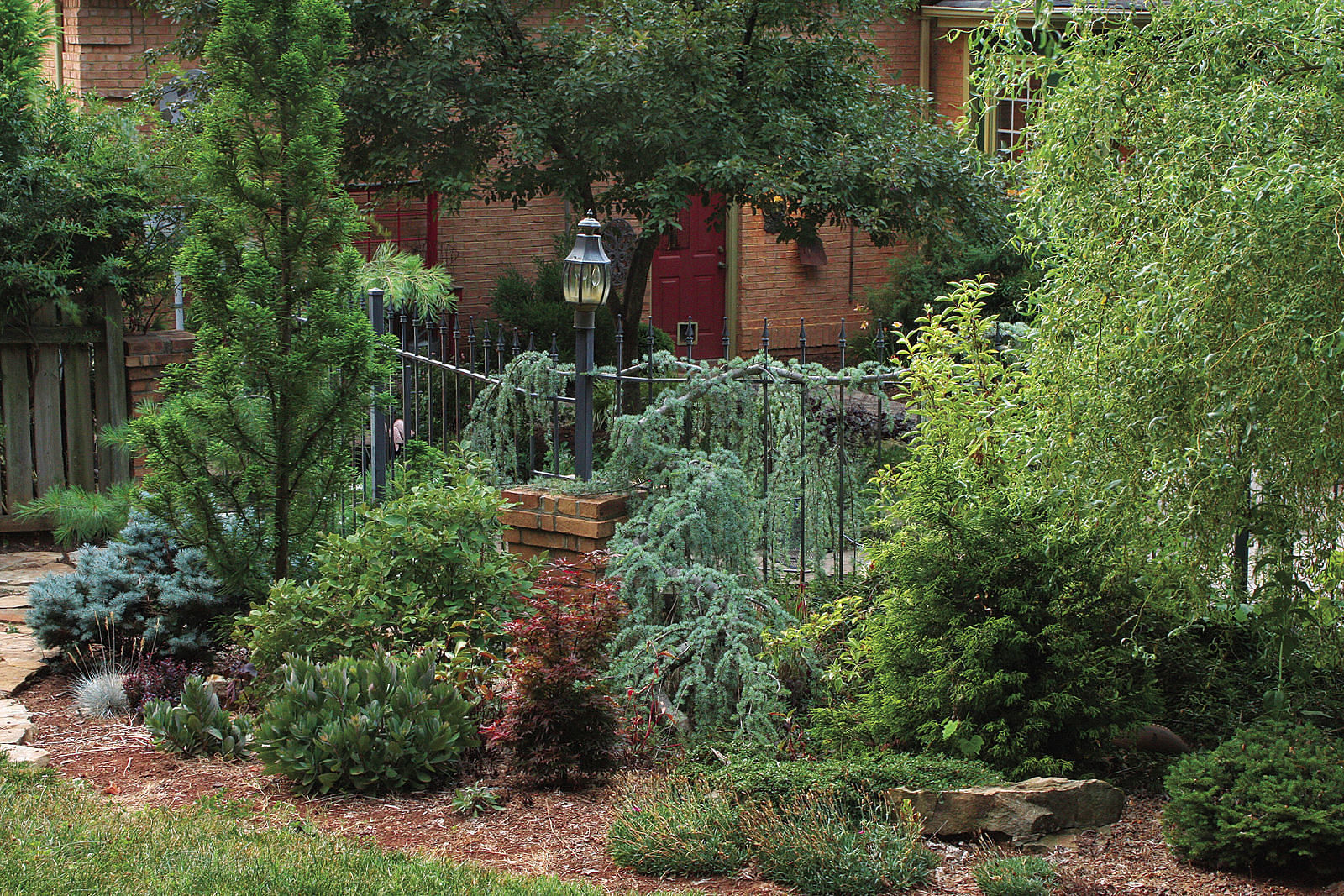
My favorite shapes to work with are vertical, which can also be the trickiest to place correctly. These are usually the conifers with the strongest, most pronounced silhouettes, and I love to use them as focal points at the ends of my beds. Their forceful forms tie the garden to surrounding buildings, tree lines, and the next section of the landscape. Among my favorite plants to use are ‘Sulphurea’ Arizona cedar (Cupressus arizonica var. glabra ‘Sulphurea’, USDA Hardiness Zones 6–9), weeping Norway spruce (Picea abies ‘Pendula’, Zones 3–8), and weeping blue Atlas cedar (Cedrus atlantica ‘Glauca Pendula’, Zones 6–9). It’s important to remember that strong vertical forms (weeping or not) don’t look great in the middle of a garden because when all the perennials die back, the conifer will stick out and become an eyesore.
It’s better to use round shapes in the middle of beds, where their well-defined bulk can be appreciated, whether standing alone in winter or commingling nicely with other plants the rest of the year. With prostrate, ground-hugging conifers, you generally have no choice other than to place them at the edges of the beds. This is a blessing, though, because conifers will survive in places with lean soil and high traffic. In these spots, they are also able to hide the bottoms of deciduous plants, giving the beds a fuller appearance.
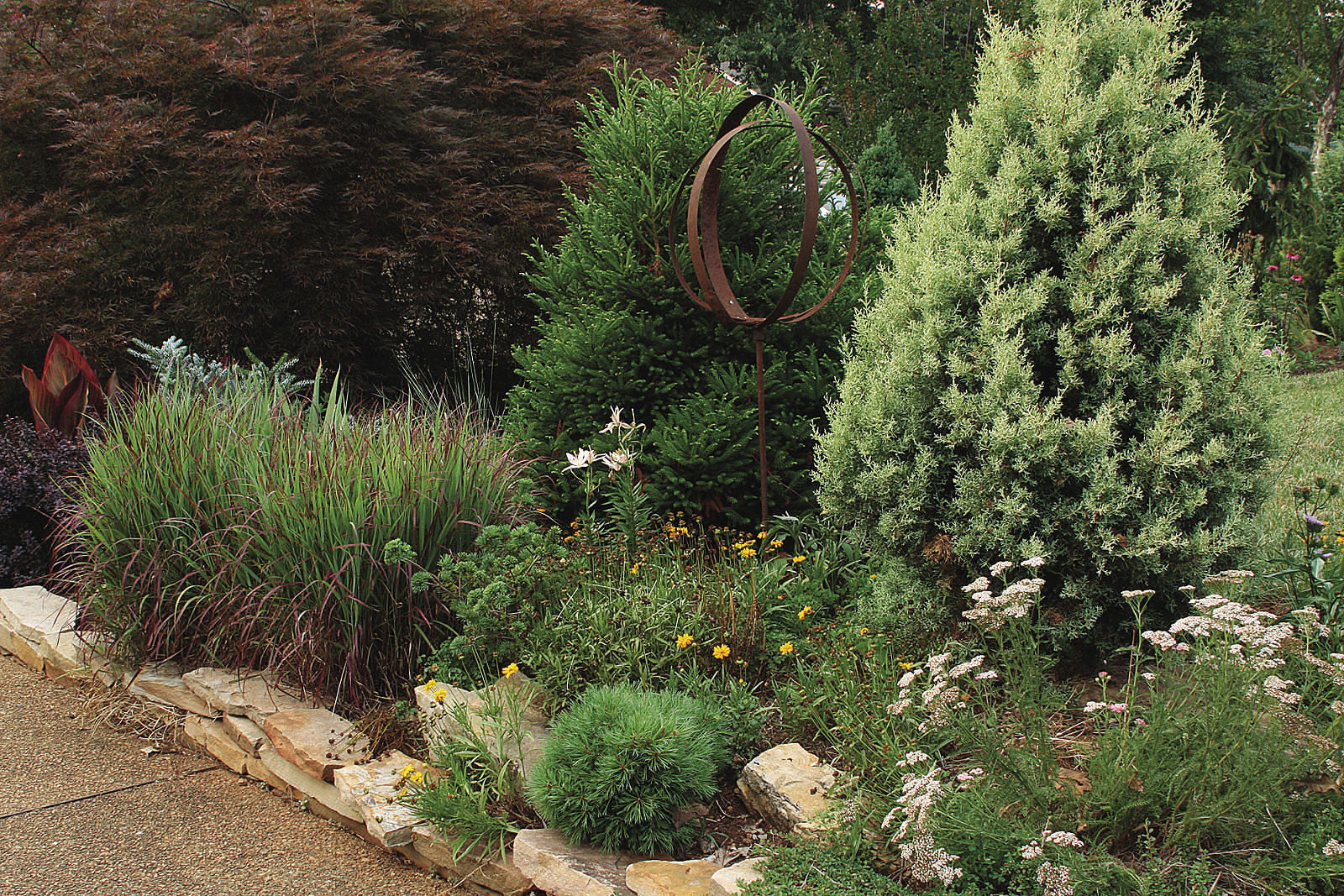
Infuse a little extra texture, even in the shade
Striking plant combinations are made when you pair coarse-textured plants with those that are fine. Because color in the shade can be hard to come by, texture becomes all the more essential to create interest. Shade gardeners like to rely on big bold plants, like ligularias (Ligularia spp. and cvs., Zones 4–8) and hostas (Hosta spp. and cvs., Zones 3–9). But conifers can add a fine, needlelike texture rarely found in shade-loving perennials. Careful placement of these needled gems next to a bold-leaved plant creates a dynamic pairing seldom seen in dark spots.
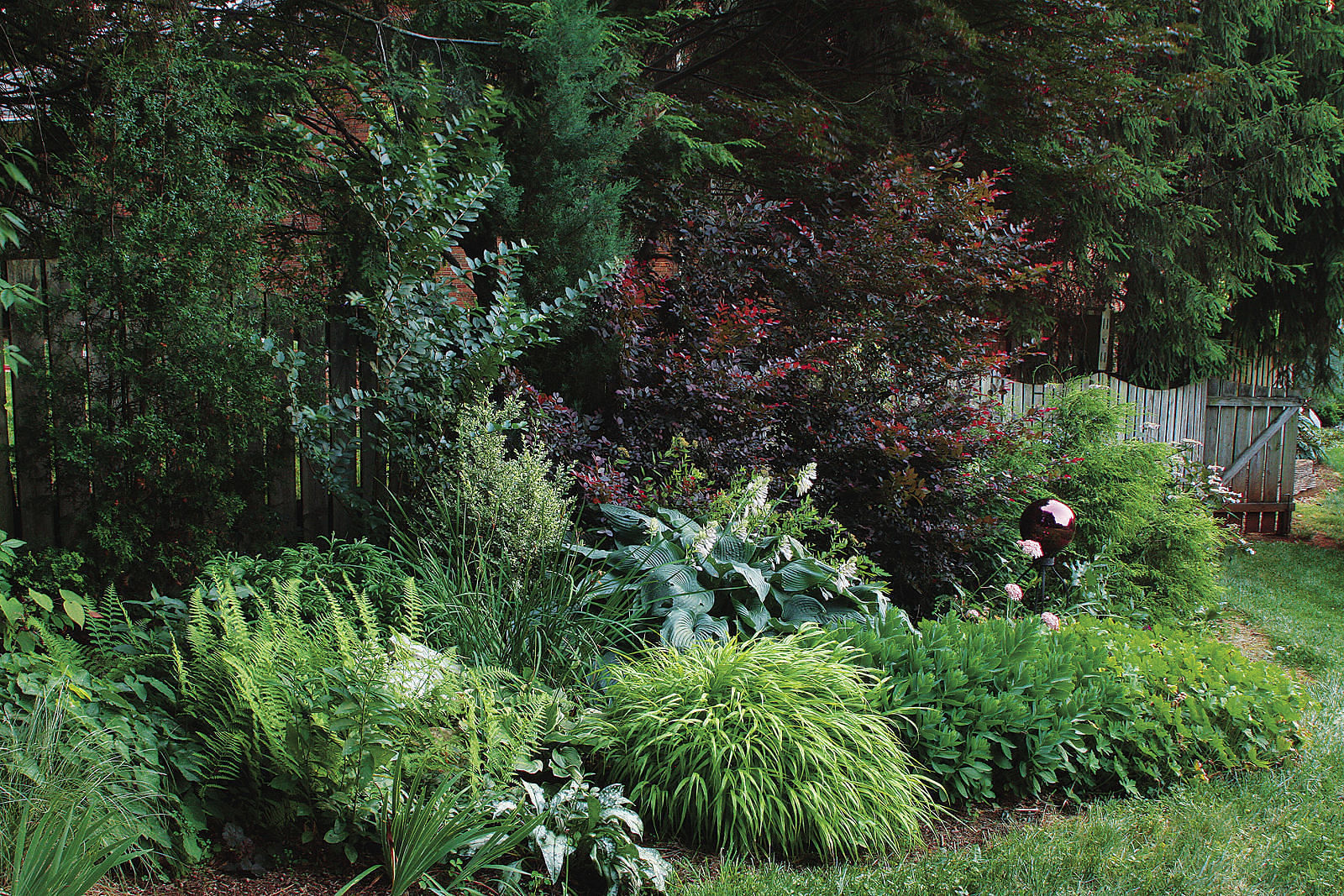
One of my favorite fine-textured conifers to use in the shade is dwarf Japanese cedar (Cryptomeria japonica ‘Globosa Nana’, Zones 6–9). The threadlike foliage and yellow-green color make this a striking evergreen. ‘Golden Mop’ false cypress (Chamaecyparis pisifera ‘Golden Mop’, Zones 4–8) has similar foliage but with a slightly weeping habit. Most white pines will also thrive in the shade and add some amazing fine texture. My favorite is ‘Greg’ (Pinus strobus ‘Greg’, Zones 4–9) because it looks as soft as it feels. It is one of the smallest white pines, growing to just 3 feet tall and wide. Its petite size makes it perfect for snuggling up against a large-leaved hosta.
Conifer texture can be an asset in the sun, too. But because the competition for your eye is greater (with more flowers and colors to contend with), the texture of your conifer must be truly bold. Blue China fir (Cunninghamia lanceolata ‘Glauca’, Zones 7–9), for example, is a coarse-textured favorite of mine that can grow quite large, but its steely blue needles are stunning when paired with fine-textured herbaceous friends.
Place the brightest colors in spots that lack mid- or end-of-season interest
Although conifers are thought of primarily for their winter interest, they are equally important for their summer color—especially in areas of the country that get exceptionally hot and where perennials tend to suffer. In spots where mid- to late-summer color is lacking, plant a colorful conifer. This ensures that the garden still looks vibrant during the peak season, despite soaring temperatures. Remember, too, that conifers get the most spectacular color in full sun. Of course, green is the predominant hue in the world of conifers, but there are stellar yellow and gold selections as well as steely blues, stunning whites, and even plum and mahogany options. Select just two dominant colors when deciding on which conifers to plant because color repetition will help the garden blend better. I use yellow and silvery blue.

One of my favorite yellow conifers—for its bright lime-yellow foliage—is ‘Morgan’ Oriental arborvitae (Platycladus orientalis ‘Morgan’, Zones 5–8). It is one of the most durable conifers, tolerating a range of soil conditions from extremely dry to boggy wet, which guarantees that you’ll always have blazing color wherever it is planted. ‘Saybrook Gold’ juniper (Juniperus chinensis ‘Saybrook Gold’, Zones 3–9) is another good choice for a splash of gold in a lower-growing form. There are so many beautiful silvery blue conifers out there, it’s hard to choose a favorite. But if pressed, I would say that tall and stately ‘Karl Fuchs’ deodar cedar (Cedrus deodara ‘Karl Fuchs’, Zones 6–9) is at the top of my list. It is widely available and adds a lightning bolt of color to any spot. If you’re looking for a similar hue but in a much smaller plant, I love ‘Silberlocke’ Korean fir (Abies koreana ‘Silberlocke’, Zones 5–8) because it is exceptionally slow growing, has great heat tolerance, and absolutely glows when paired with dark-leaved perennials.
With careful attention paid to the placement of your colorful and uniquely textured conifers, you can have a beautiful garden that is lower maintenance than most. And the older you get, the more care-free plants you’ll want in your garden, allowing you to spend your time on other things—like enjoying the fruits of your labor.
Overcoming conifer conundrums
Although conifers are beautiful additions to the landscape, many gardeners have reservations about basing a design around these pricey plants. After many years of trial and error, here is what I’ve discovered about some design challenges that come with conifers:
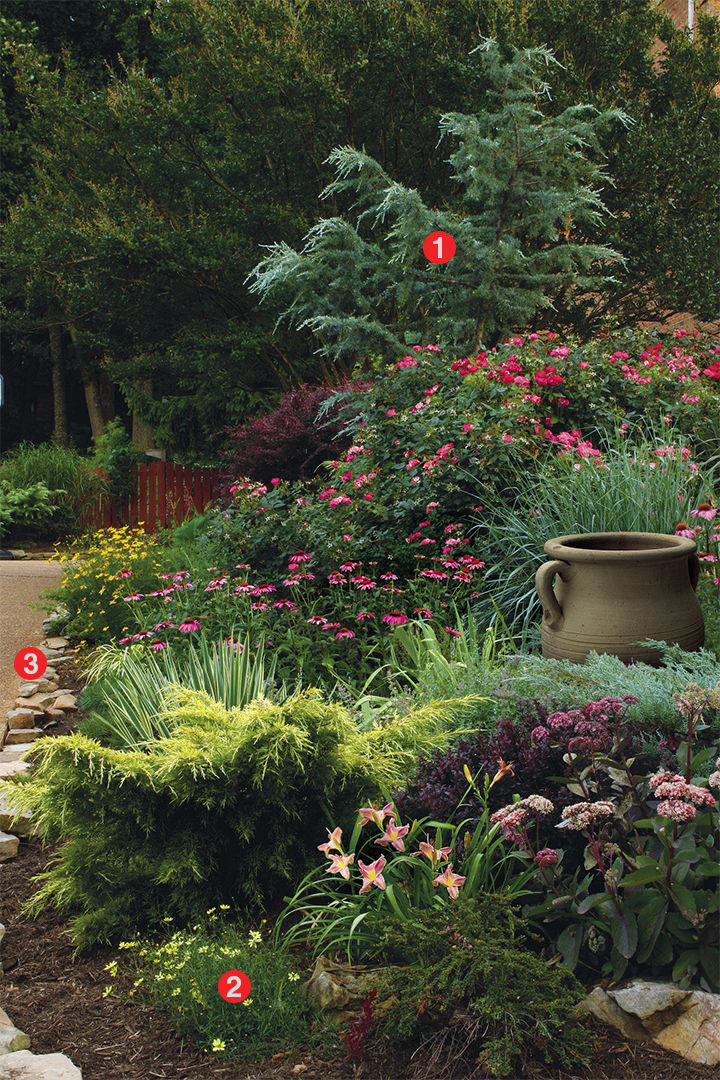
How do I know if I have enough conifers?
Any garden should be the perfect balance of perennials, annuals, trees/shrubs, and conifers; therefore, I think a garden should be roughly 25 percent conifers. This proportion ensures that your beds will look great year-round and be lower maintenance yet won’t look like a collection at a botanical garden. Anything less than 10 percent conifers really won’t make an impact.
How do you compensate for the gaps while your conifers fill in?
These areas are the perfect spot for annuals or tropicals; as the conifer slowly expands, the number of tender plants needed to fill the holes will become smaller. Or just use perennials, and move them when they start to get crowded out. I’ve also found that many perennials will actually take control of the situation and will start growing out from underneath an imposing conifer.
What about challenging sites?
Conifers are some of the most durable and tolerant plants you can use, even in difficult areas. No matter what site you have—a boggy, damp spot; a steep, sunny slope; a sun-baked driveway strip; or dry shade—there is a conifer that can tolerate it. Because of this, I like to think of conifers as double-duty plants: They can solve your difficult site situation while providing beauty with their noteworthy form, color, and texture. Arborvitae (Thuja spp. and cvs., Zones 2–9), for example, can survive almost anywhere, and for dry shade, you can’t go wrong with Siberian cypress (Microbiota decussata, Zones 3–7).
Susan Hamilton is the director of the University of Tennessee Gardens in Knoxville and is the president of the American Conifer Society—Southeastern Region.
Photos: Danielle Sherry
Fine Gardening Recommended Products

Gardener's Log Book from NYBG
Fine Gardening receives a commission for items purchased through links on this site, including Amazon Associates and other affiliate advertising programs.

Berry & Bird Rabbiting Spade, Trenching Shovel
Fine Gardening receives a commission for items purchased through links on this site, including Amazon Associates and other affiliate advertising programs.



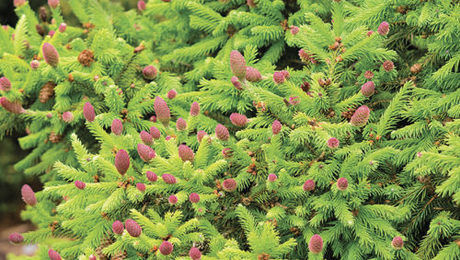
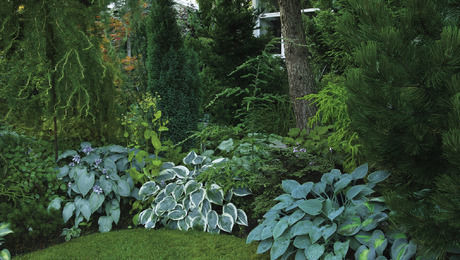













Comments
Log in or create an account to post a comment.
Sign up Log in